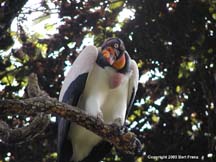 A few of the
many highlights of
previous trips are Great and Slaty-breasted Tinamous, nesting Jabirus, soaring King Vultures
A few of the
many highlights of
previous trips are Great and Slaty-breasted Tinamous, nesting Jabirus, soaring King VulturesFORESTS &
SAVANNAS
Year after year we keep coming back to the Rio Bravo Conservation Area because it offers the best combination of an excellent local birding guide, pleasant accommodations and an amazing array of birds. In 2006 we found 205 species and 213 in 2007 on this side trip and cumulatively, we've encountered 290 species. Since 2006 we expanded the side-trip to 4-day/3-night and including a visit to Chan Chich, which shares the same forested area as La Milpa in western Belize, just east of the Guatemala border.
 A few of the
many highlights of
previous trips are Great and Slaty-breasted Tinamous, nesting Jabirus, soaring King Vultures
A few of the
many highlights of
previous trips are Great and Slaty-breasted Tinamous, nesting Jabirus, soaring King Vultures,
Ornate and Black Hawk-Eagles, dozens of Ocellated Turkeys
, Crested Guans
and Great Currasows, excellent views of secretive Barred Forest-Falcons, eight
species of Woodcreepers, finding elusive flycatchers such as Ochre-bellied
Flycatcher, Northern Bentbill, Eye-ringed Flatbill and Royal Flycatcher and
watching Giant Cowbirds invade the nesting trees of Montezuma Oropendolas.
This year we will have access to the trails leading through 260,000 acres managed by Programme for Belize and we will have a local guide to provide us with the best
opportunity to find the area's specialties. This area boasts 392 species of birds, 200
species of trees, 70 species of mammals and 12 endangered animal species.
Members of our group have seen Ocelot, Kinkajou, Tayra, Spider Monkey, Wooly Opossum and other
mammals. The La Milpa
Archaeological Site includes a royal Maya tomb that in 1996 was discovered to hold a male
skeleton adorned with a jeweled necklace.
From the RV campsite in Orange Walk, we will start our trip early in the morning, using our cars and trucks, leaving our RV's behind. We'll leave early enough in the morning to hear owls and nightjars at August Pine Ridge. A significant portion of the trip will be on gravel roads, easily managed, but at a slower pace, both for the birding opportunities in route as well as the road condition. Parrots feeding in the sorghum fields and kites and falcons are often seen along this road. If the wetlands are still flooded we may see Jabiru. We will arrive at Rio Bravo Conservation and Management Area by lunch time, spend three nights at La Milpa and return to Orange Walk the following day.
We will be staying at the La Milpa Field Station ,
an attractive collection of cabanas, dormitory, dining room, conference/training room,
library, gift shop and leisure areas nestled in a grassy open spot in the midst of the
dense forest. These are the same facilities used by Massachusetts Audubon, New Jersey
Audubon and the American Birding Association in the past. Cabanas have
private baths with hot showers. Dormitories have shared bathrooms with
cold showers.
Price depends on your choice of room. Both choices include the complete package as described above.